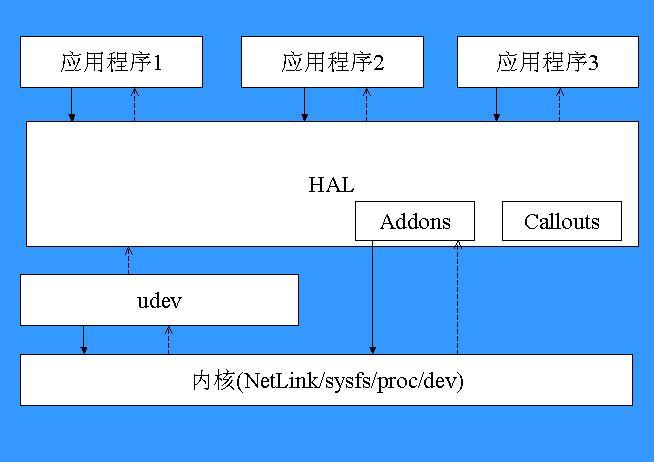Linux HAL (Hardware Abstraction Layer)的工作原理
转载时请注明出处和作者联系方式:http://blog.csdn.net/absurd
作者联系方式:李先静<xianjimli at hotmail dot com>
更新时间:2007-5-3
HAL是Hardware Abstraction Layer的首字母缩写。我最早是在Winnt 3.5的帮助中知道这个名词的,对帮助文档中的说法我比较认同,所以一直对它抱有好感。不过Windows下的HAL和Linux下的HAL两者所指并非相同之物:
Windows下的HAL:位于操作系统的最底层,直接操作物理硬件,隔离与硬件相关的信息,为上层的操作系统和设备驱动程序提供一个统一的接口,起到对硬件的抽象作用。有了HAL,编写驱动程序就容易多了,因为HAL的接口不但使用简单,而且具有更好的可移植性(没用过)。
Linux 下的HAL:至于对硬件的抽象,Linux内核早就有类似机制,只不过没有专门的名称罢了。而Linux的HAL指的并非这个,它不是位于操作系统的最底层,直接操作硬件,相反,它位于操作系统和驱动程序之上,是一个运行在用户空间中服务程序。
我们知道,Linux和所有的Unix一样,习惯用文件来抽象设备,任何设备都是一个文件,比如/dev/mouse是鼠标的设备文件。这种方法看起来不错,每个设备都有统一的形式,但使用并不那么容易,设备文件名没有什么规范,从简单的一个文件名,你无法得知它是什么设备,具有有什么特性。
结果形成这样的尴尬:有了设备和设备驱动程序,却不知道如何使用它。这些乱七八糟的设备文件,让设备的管理和应用程序的开发都变得很麻烦,所以有必要提供一个硬件抽象层,来为上层应用程序提供一个统一的接口,Linux的HAL就这样应运而生了。
但HAL并不提供诸如拍照和刻录等之类的功能,相反它只是告诉应用程序,系统中有哪些设备可用,以及这些设备的类型、特性和能力等。主要说来,它提供以下几项功能:
1. 获取指定类型的设备列表。
2. 获取/更改设备的属性值。
3. 获取设备具有的能力描述。
4. 设备插入/拔除时,通知相关应用程序。
5. 设备属性或能力变化时,通知相关应用程序。
udev创建dev下的文件结点,加载驱动程序,让设备处于可用状态。而HAL则告诉应用程序,现在有哪些设备可用,这些设备的类型、特性和能力,让应用程序知道如何使用它们。
设备的属性管理是HAL最重要任务之一,有的设备属性来源于实际的硬件,有的来源于设备信息文件(/usr/share/hal/fdi/),有的来源其它配置信息(如/usr/share/hwdata/)。设备属性的都有标准的定义,这些属性定义是HAL的SPEC的主要内容之一,可以参考http://people.freedesktop.org/~david/hal-spec/hal-spec.html。
HAL作为一个后台服务程序运行,它的主体架构基于MVC的模型,在DBUS的帮助下,实现了异步事件通知机制。HAL的分层视图如下:

说明:
1. 实线箭头为主动调用,虚线箭头为事件上报。
2. udev通过NetLink注册内核的设备事件,当有设备插入/拔除时,udev就会收到通知,它会从事件中所带参数和sysfs中的信息,加载适当的驱动程序,创建dev下的结点,让设备处于可用的状态。
3. udev只是一个框架,它的行为完全受它的规则所控制,这些规则存放在目录/etc/udev/rules.d/中,其中90-hal.rules是用来让udev把设备插入/拔除的事件通过socket socket:/org/freedesktop/hal/udev_event转发给HAL的。
4. HAL挂在socket:/org/freedesktop/hal/udev_event上等待事件,有事件发生时就调用函数hald_udev_data处理,它先从事件中取出主要参数,创建一个hotplug_event对象,把它放入事件队列中,然后调用hotplug_event_process_queue处理事件。
5. 函数hotplug_event_begin负责具体事件的处理,它把全部事件分为四类,并分别处理hotplug_event_begin_sysfs处理普通设备事件,hotplug_event_begin_acpi处理ACPI事件,hotplug_event_begin_apm处理APM事件,hotplug_event_begin_pmu处理PMU事件。要注意的是,后三者的事件源并非源于udev,而是在device_reprobe时触发的(osspec_device_reprobe/hotplug_reprobe_tree/hotplug_reprobe_generate_add_events/acpi_generate_add_hotplug_event)。
6. 函数hotplug_event_begin_sysfs中,如果是插入设备,则创建一个设备对象,设置设备的属性,调用相关callouts,然后放入设备列表中,并触发signal让dbus通知相关应用程序。如果是拔除设备,则调用相关callouts,然后从设备列表中删除,并触发signal让dbus通知相关应用程序。
7. 应用程序可以主动调用HAL提供的DBUS接口函数,这些函数在libhal.h中有定义。应用程序也可以注册HAL的signal,当设备变化时,HAL通过DBUS上报事件给应用程序。
8. callout是HAL一种扩展方式,它在设备插入/拔除时执行。可以在设备信息文件中(/usr/share/hal目录)指定。
9. addon也是HAL一种扩展方式,它与callout的不同之处在于addon往往是事件的触发者,而不是事件的消费者。HAL的事件源主要源于udev,而udev源于kernel的hotplug,然而有的设备如电源设备、磁盘设备和特殊按键等,它们并不产生hotplug事件。HAL就得不到通知,怎么办呢,addon就是用于支持新事件源的扩展方式。比如addon-acpi从/proc/acpi/event或者/var/run/acpid.socket收到事件,然后转发成HAL事件。addon-storage检测光盘或磁盘的状态,并设置设备的属性。addon-keyboard检测一些特殊按键,并触发相应事件。
access-check/ci-tracker/ck-tracker负责权限的检查,里面提到的PolicyKit/ConsoleKit不是太熟悉,有时间再看看。
简单的说,HAL就是一个设备数据库,它管理当前系统中所有的设备,你可以以多种灵活的方式去查询这些设备,可以获取指定设备的特性,可以注册设备变化事件。
~~end~~





















 896
896











 被折叠的 条评论
为什么被折叠?
被折叠的 条评论
为什么被折叠?








